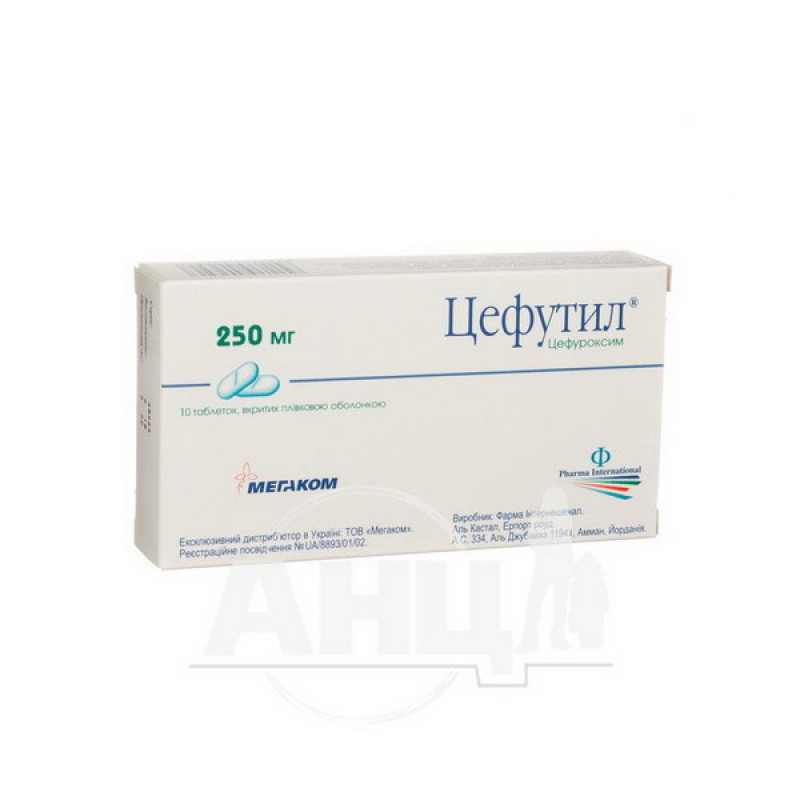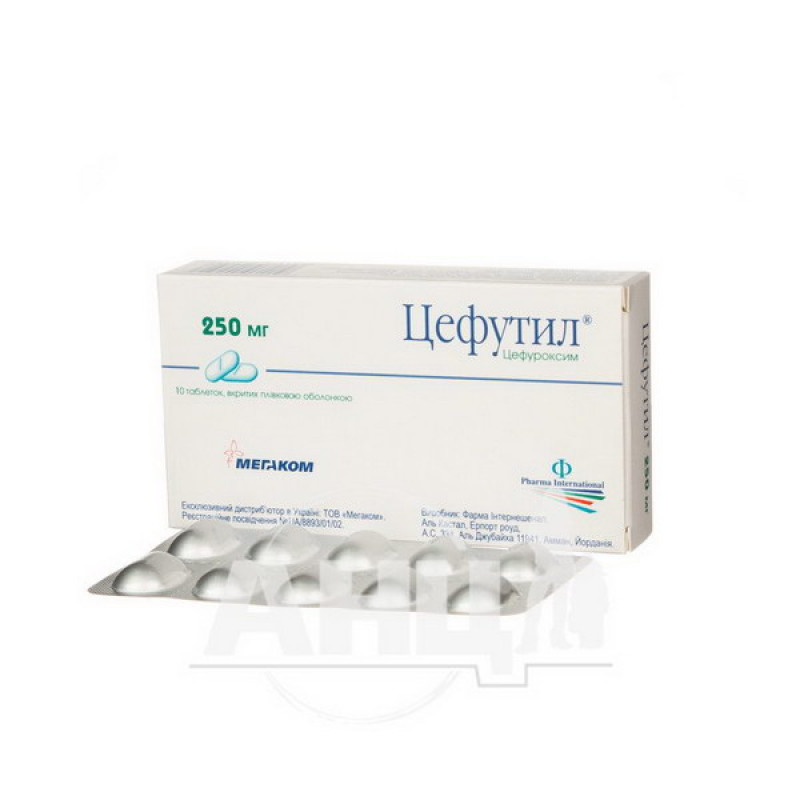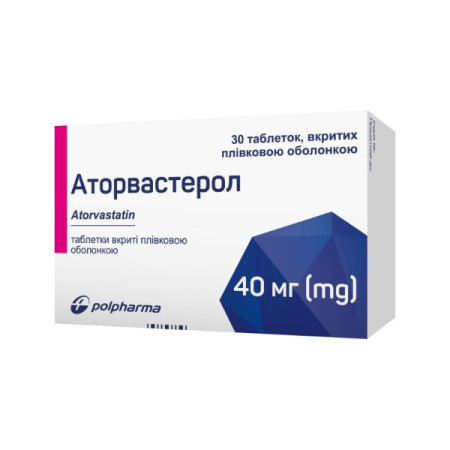Cefutil film-coated tablets 250 mg blister No. 10

Cefutil ® tablets are intended for the treatment of the following infections:
Acute streptococcal tonsillitis and pharyngitis; Acute bacterial sinusitis; Acute otitis media; Exacerbation of chronic bronchitis caused by pathogens sensitive to cefuroxime axetil; Cystitis; Pyelonephritis; Uncomplicated skin and soft tissue infections; Early manifestations of Lyme disease.Composition
The active substance is cefuroxime (one tablet contains cefuroxime (in the form of axetil) 250 mg).
Excipients: microcrystalline cellulose, croscarmellose sodium, sodium starch glycolate (type A), sodium lauryl sulfate, colloidal anhydrous silica, magnesium stearate, Opadry OY-L white (contains: lactose, monohydrate; titanium dioxide (E 171); hydroxypropylmethylcellulose; polyethylene glycol), FD&C blue dye No. 1 (E 133), polyethylene glycol 6000.
Contraindication
Hypersensitivity to cephalosporin antibiotics, cefuroxime and to any of the components of the drug; history of severe hypersensitivity reactions (e.g. anaphylactic reactions) to any other type of beta-lactam antibiotics (penicillins, monobactams and carbapenems).Method of application
Antibiotic susceptibility varies by region and may change over time. Local antibiotic susceptibility data should be consulted if necessary.
Usually the duration of treatment is 7 days (can be from 5 to 10 days).
For better absorption, it is recommended to take the drug after meals.
Adults and children (≥ 40 kg):
acute tonsillitis and pharyngitis, acute bacterial sinusitis - 250 mg 2 times a day; acute otitis media - 500 mg 2 times a day; exacerbation of chronic bronchitis - 500 mg 2 times a day; cystitis - 250 mg 2 times a day; pyelonephritis - 250 mg 2 times a day; uncomplicated skin and soft tissue infections - 250 mg 2 times a day; Lyme disease - 500 mg 2 times a day for 14 days (therapy may last from 10 to 21 days).Children (<40 kg):
acute tonsillitis and pharyngitis, acute bacterial sinusitis - 10 mg/kg 2 times a day, maximum dose - 125 mg 2 times a day; children from 2 years of age with otitis media or, if necessary, with more serious infections - 15 mg/kg 2 times a day, maximum dose - 250 mg 2 times a day; cystitis - 15 mg/kg 2 times a day, maximum dose - 250 mg 2 times a day; pyelonephritis - 15 mg/kg 2 times a day, maximum dose - 250 mg 2 times a day for 10-14 days; uncomplicated skin and soft tissue infections - 15 mg/kg 2 times a day, maximum dose - 250 mg 2 times a day; Lyme disease - 15 mg/kg 2 times a day, maximum dose - 250 mg 2 times a day for 14 days (from day 10 to day 21).Cefutil ® tablets cannot be broken, so they are not prescribed to patients who cannot swallow them. It is recommended to prescribe the drug in the form of a suspension to children.
Cefuroxime is also available as a sodium salt for parenteral use. This allows sequential therapy with a single antibiotic when switching from parenteral to oral administration, if clinically indicated.
"Cefutil ®" is effective for the sequential treatment of exacerbations of chronic bronchitis after previous parenteral administration of cefuroxime sodium.
Sequential therapy
Exacerbation of chronic bronchitis: 750 mg of cefuroxime 2-3 times a day (intravenously or intramuscularly) for 48-72 hours, followed by the use of the drug "Cefutil ®" 500 mg 2 times a day for 5-10 days.
The duration of both parenteral and oral treatment should be determined taking into account the severity of the infection and the patient's condition.
Application features
Pregnant women
There are limited data on the use of cefuroxime in pregnant women. This drug should be prescribed to pregnant women only in cases where the benefits of using the drug outweigh the possible risks.
Cefuroxime passes into breast milk in small quantities. When using therapeutic doses of the drug, the development of adverse reactions is not expected, but the risk of diarrhea or fungal infection of the mucous membranes cannot be excluded. Therefore, in connection with these reactions, it may be necessary to stop breastfeeding. The possibility of a sensitizing effect of the drug should also be taken into account. Cefuroxime is prescribed during breastfeeding only after a doctor has assessed the benefit-risk ratio of its use.
There are no data on the effect of cefuroxime axetil on fertility in humans. Animal reproduction studies have not shown any effect of this medicinal product on fertility.
Children
There is no experience with the use of cefuroxime axetil in the treatment of children under 3 months of age.
Drivers
Since the drug may cause dizziness, patients should be warned to use caution when driving or operating machinery.
Overdose
Overdose of cephalosporins may cause brain irritation and neurological complications, including encephalopathy, convulsions, and coma. Symptoms of overdose may occur if the dose of the drug has not been appropriately adjusted for patients with impaired renal function.
Serum levels of cefuroxime can be reduced by hemodialysis and peritoneal dialysis.
Side effects
Adverse reactions to cefuroxime axetil are mild and generally reversible.
Blood and lymphatic system disorders: eosinophilia, positive Coombs test, thrombocytopenia, leukopenia (sometimes profound), hemolytic anemia.
Cephalosporins as a class have the property of being absorbed on the surface of the erythrocyte membrane and interacting with antibodies there, which can lead to a positive Coombs test (impact on blood compatibility) and (very rarely) to hemolytic anemia.
On the part of the immune system: hypersensitivity reactions, including skin rash, urticaria, itching, drug fever, serum sickness, anaphylactic shock, Jarisch-Herxheimer reaction.
From the nervous system: headache, dizziness.
Gastrointestinal: Gastroenterological disorders including diarrhea, nausea, abdominal pain, vomiting, pseudomembranous colitis.
On the part of the hepatobiliary system: transient increase in liver enzymes (ALT, AST, LDH), jaundice (mainly cholestatic), hepatitis.
Skin and subcutaneous tissue disorders: erythema multiforme, Stevens-Johnson syndrome, toxic epidermal necrolysis (exanthematous necrolysis); angioedema.
Storage conditions
Store in the original packaging at a temperature not exceeding 30 °C, out of the reach of children. Do not freeze.
Shelf life - 4 years.
There are no reviews for this product.
There are no reviews for this product, be the first to leave your review.
No questions about this product, be the first and ask your question.







